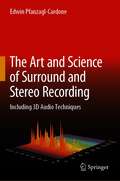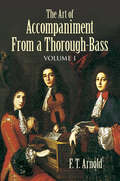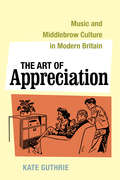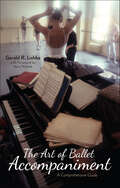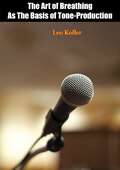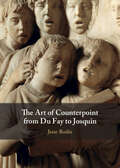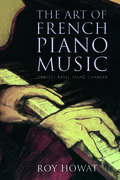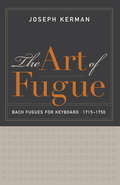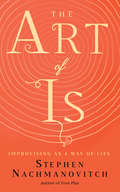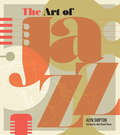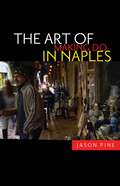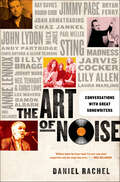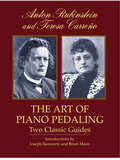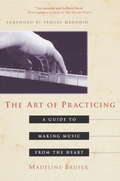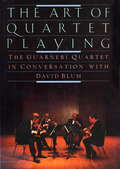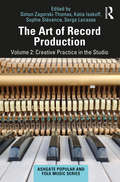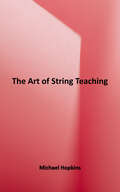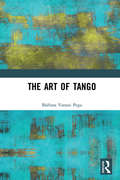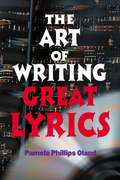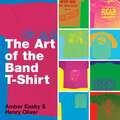- Table View
- List View
The Art and Science of Surround and Stereo Recording: Including 3D Audio Techniques
by Edwin Pfanzagl-CardoneThis book presents an extensive and timely survey of more than 30 surround and 20 stereo-microphone techniques. Further, it offers, for the first time, an explanation of why the RCA "Living Stereo" series of legacy recordings from the 1950s and 60s is still appreciated by music lovers worldwide, despite their use of an apparently incorrect recording technique from the perspective of psychoacoustics. Discussing this aspect in detail, the book draws on the author’s study of concert hall acoustics and psychoacoustics. The book also analyzes the "fingerprint" features of a selected number of surround and – more importantly – stereo microphone techniques in depth by measuring their signal cross-correlation over frequency and also using an artificial human head. In addition, the book presents a rating of microphone techniques based on the assessment of various acoustic attributes, and merges the results of several subjective listening tests, including those conducted by other researchers. Building on this knowledge, it provides fresh insights into important microphone system features, from stereo to 3D audio. Moreover, it describes new microphone techniques, such as AB-PC, ORTF-T and BPT, and the recently defined BQIrep (Binaural Quality Index of reproduced music). Lastly, the book concludes with a short history of microphone techniques and case studies of live and studio recordings.
The Art of Accompaniment from a Thorough-Bass: As Practiced in the XVII and XVIII Centuries, Volume I (Dover Books On Music: Analysis)
by F. T. ArnoldA solid grounding in musical techniques of the 17th and 18th centuries is essential to a complete understanding of Baroque music. Arnold's legendary work is a comprehensive survey of the topic, covering every issue of significance to today's performers. The text is fully amplified with numerous musical examples, authoritative citations, scholarly interpretations and syntheses, and the author's own conclusions. This rich collection of source material for the musicologist is an equally indispensable companion for conductors, editors, and performers.
The Art of Appreciation: Music and Middlebrow Culture in Modern Britain (California Studies in 20th-Century Music #30)
by Kate GuthrieFrom the BBC Proms to Bernstein's Young People's Concerts, initiatives to promote classical music have been a pervasive feature of twentieth-century musical life. The goal of these initiatives was rarely just to reach a larger and more diverse audience but to teach a particular way of listening that would help the public "appreciate" music. This book examines for the first time how and why music appreciation has had such a defining and long-lasting impact—well beyond its roots in late-Victorian liberalism. It traces the networks of music educators, philanthropists, policy makers, critics, composers, and musicians who, rather than resisting new mass media, sought to harness their pedagogic potential. The book explores how listening became embroiled in a nexus of modern problems around citizenship, leisure, and education. In so doing, it ultimately reveals how a new cultural milieu—the middlebrow—emerged at the heart of Britain's experience of modernity.
The Art of Ballet Accompaniment: A Comprehensive Guide
by Gerald R. LishkaThe Art of Ballet Accompaniment: A Comprehensive Guide addresses every imaginable topic and challenge that a ballet accompanist—whether a novice or a more experienced practitioner—might encounter.More than just a facile anthology of accessible music, this inclusive guide details all aspects of playing for ballet, including a complete manual for editing piano literature to accompany ballet technique classes. Author Gerald R. Lishka encourages ballet accompanists to be imaginative, creative, independent artists who can also communicate effectively with dance instructors. In addition, he clarifies the necessary balance between the use of existing musical scores and the art of improvisation. Featuring a new foreword by Kyra Nichols, an expanded section on Lishka's personal philosophy, an updated section on barre from Alison Hennessey, and over 100 music examples, The Art of Ballet Accompaniment offers invaluable advice for all levels of pianists and accompanists.
The Art of Breathing As The Basis of Tone-Production: (the Old Italian School Of Singing) Indisensable To Singers, Elocutionists, Educators ... And To All Others Desirous Of Having A Pleasant Voice And Good Health
by Leo KoflerGuide to breathing for singers and public speakers, referencing the theory of breathing, expiration during singing, control of the breath, tone-production, resonance-chambers, and more; “My book differs from the great majority of other works upon voice-culture in still another respect. The majority have been writ ten when their authors were yet in the teens of their professional career. In perusing these volumes we come across many' places where the thought involuntarily crosses our minds: How much better it would have been if the author had waited twenty years before writing his book! I entered the musical profession young in life, and have always been a very close student, especially of vocal science; still I did not dare to come out with one printed sentence until I was satisfied that I could say something that had been matured within myself, and that had borne fruit for years in the many pupils who do credit to the principles Of my book. To the friends of the first edition, who may miss a great many things in this volume that were in The Old Italian School, I wish to say that my intention is to publish the remainder some day in a separate book. The reason that I have paid so much attention to the laws of tone-production is because I know that without them voice-culture is a farce, and instead of leading to artistic singing, vocal instruction is degraded to a system of tricks and to virtuosity in howling.”
The Art of Counterpoint from Du Fay to Josquin
by Jesse RodinThis book transforms our understanding of a fifteenth-century musical revolution. Renaissance composers developed fresh ways of handling musical flow in pursuit of intensifications, unexpected explosions, dramatic pauses, and sudden evaporations. A new esthetics of opposition, as this study calls it, can be contrasted with smoother and less goal-oriented approaches in music from before – and after – the period ca. 1425–1520. Casting wide evidentiary and repertorial nets, the book reinterprets central genres, theoretical concepts, historical documents, famous pieces, and periodizations; a provocative concluding chapter suggests that we moderns have tended to conceal the period's musical poetics by neglecting central evidence. Above all the book introduces an analytical approach sensitive to musical flow and invites new ways of hearing, performing, and thinking about music from Du Fay to Josquin.
The Art of Digital Orchestration
by Sam McGuire Zbyněk MatějůThe Art of Digital Orchestration explores how to replicate traditional orchestration techniques using computer technology, with a focus on respecting the music and understanding when using real performers is still the best choice. Using real-world examples including industry-leading software and actual sounds and scores from films, VR/AR, and games, this book takes readers through the entire orchestration process, from composition to instruments, performance tools, MIDI, mixing, and arranging. It sheds light on the technology and musical instrument foundation required to create realistic orchestrations, drawing on decades of experience working with virtual instruments and MIDI. Bringing together the old and new, The Art of Digital Orchestration is an excellent resource for anyone using software to write or compose music. The book includes access to online videos featuring orchestration techniques, MIDI features, and instrument demonstrations.
The Art of French Piano Music: Debussy, Ravel, Fauré, Chabrier
by Roy HowatAn essential resource for scholars and performers, this study by a world-renowned specialist illuminates the piano music of four major French composers, in comparative and reciprocal context. Howat explores the musical language and artistic ethos of this repertoire, juxtaposing structural analysis with editorial and performing issues. He also relates his four composers historically and stylistically to such predecessors as Chopin, Schumann, Liszt, the French harpsichord school, and Russian and Spanish music. Challenging long-held assumptions about performance practice, Howat elucidates the rhythmic vitality and invention inherent in French music. In granting Fauré and Chabrier equal consideration with Debussy and Ravel, he redresses a historic imbalance and reshapes our perceptions of this entire musical tradition. Outstanding historical documentation and analysis are supported by Howat's direct references to performing traditions shaped by the composers themselves. The book balances accessibility with scholarly and analytic rigor, combining a lifetime's scholarship with practical experience of teaching and the concert platform
The Art of Fugue
by Joseph KermanA free ebook version of this title is available through Luminos, University of California Press' new open access publishing program for monographs. Visit www.luminosoa.org to learn more. Fugue for J. S. Bach was a natural language; he wrote fugues in organ toccatas and voluntaries, in masses and motets, in orchestral and chamber music, and even in his sonatas for violin solo. The more intimate fugues he wrote for keyboard are among the greatest, most influential, and best-loved works in all of Western music. They have long been the foundation of the keyboard repertory, played by beginning students and world-famous virtuosi alike. In a series of elegantly written essays, eminent musicologist Joseph Kerman discusses his favorite Bach keyboard fugues--some of them among the best-known fugues and others much less familiar. Kerman skillfully, at times playfully, reveals the inner workings of these pieces, linking the form of the fugues with their many different characters and expressive qualities, and illuminating what makes them particularly beautiful, powerful, and moving. These witty, insightful pieces, addressed to musical amateurs as well as to specialists and students, are beautifully augmented by performances made specially for this volume: Karen Rosenak, piano, playing two preludes and fugues fromTheWell-Tempered Clavier--C Major, book 1; and B Major, book 2--and Davitt Moroney playing the Fughetta in C Major, BWV 952, on clavichord; the Fugue on "Jesus Christus unser Heiland," BWV 689, on organ; and the Fantasy and Fugue in A Minor, BWV 904, on harpsichord.
The Art of Is: Improvising as a Way of Life
by Stephen NachmanovitchA MASTERFUL BOOK ABOUT BREATHING LIFE INTO ART AND ART INTO LIFE &“Stephen Nachmanovitch&’s The Art of Is is a philosophical meditation on living, living fully, living in the present. To the author, an improvisation is a co-creation that arises out of listening and mutual attentiveness, out of a universal bond of sharing that connects all humanity. It is a product of the nervous system, bigger than the brain and bigger than the body; it is a once-in-a-lifetime encounter, unprecedented and unrepeatable. Drawing from the wisdom of the ages, The Art of Is not only gives the reader an inside view of the states of mind that give rise to improvisation, it is also a celebration of the power of the human spirit, which — when exercised with love, immense patience, and discipline — is an antidote to hate.&” — Yo-Yo Ma, cellist
The Art of Jazz: A Visual History
by Alyn ShiptonThe Art of Jazz explores how the expressionism and spontaneity of jazz spilled onto its album art, posters, and promotional photography, and even inspired standalone works of fine art.Everyone knows jazz is on the cutting edge of music, but how much do you know about its influence in the visual arts? With album covers that took inspiration from the avant-garde, jazz's primarily African American musicians and their producers sought to challenge and inspire listeners both musically and visually.Arranged chronologically, each chapter covers a key period in jazz history, from the earliest days of the twentieth century to today's postmodern jazz. Chapters begin with substantive introductions and present the evolution of jazz imagery in all its forms, mirroring the shifting nature of the music itself. With two authoritative features per chapter and over 300 images, The Art of Jazz is a significant contribution to the literature of this intrepid art form.
The Art of Making Do in Naples
by Jason Pine&“In Naples, there are more singers than there are unemployed people.&” These words echo through the neomelodica music scene, a vast undocumented economy animated by wedding singers, pirate TV, and tens of thousands of fans throughout southern Italy and beyond. In a city with chronic unemployment, this setting has attracted hundreds of aspiring singers trying to make a living—or even a fortune. In the process, they brush up against affiliates of the region&’s violent organized crime networks, the camorra. In The Art of Making Do in Naples, Jason Pine explores the murky neomelodica music scene and finds himself on uncertain ground.The &“art of making do&” refers to the informal and sometimes illicit entrepreneurial tactics of some Neapolitans who are pursuing a better life for themselves and their families. In the neomelodica music scene, the art of making do involves operating do-it-yourself recording studios and performing at the private parties of crime bosses. It can also require associating with crime boss-impresarios who guarantee their success by underwriting it with extortion, drug trafficking, and territorial influence. Pine, likewise &“making do,&” gradually realized that the completion of his ethnographic work also depended on the aid of forbidding figures.The Art of Making Do in Naples offers a riveting ethnography of the lives of men who seek personal sovereignty in a shadow economy dominated, in incalculable ways, by the camorra. Pine navigates situations suffused with secrecy, moral ambiguity, and fears of ruin that undermine the anthropologist&’s sense of autonomy. Making his way through Naples&’s spectacular historic center and outer slums, on the trail of charmingly evasive neomelodici singers and unsettlingly elusive camorristi, Pine himself becomes a music video director and falls into the orbit of a shadowy music promoter who may or may not be a camorra affiliate.Pine&’s trenchant observations and his own improvised attempts at &“making do&” provide a fascinating look into the lives of people in the gray zones where organized crime blends into ordinary life.
The Art of Noise: Conversations with Great Songwriters
by Daniel RachelTHE ART OF NOISE offers an unprecedented collection of insightful, of-the-moment conversations with twenty-seven great British songwriters and composers. They discuss everything from their individual approaches to writing, to the inspiration behind their most successful songs, to the techniques and methods they have independently developed to foster their creativity. Contributors include: Sting * Ray Davies * Robin Gibb * Jimmy Page * Joan Armatrading * Noel Gallagher * Lily Allen * Annie Lennox * Damon Albarn * Noel Gallagher * Laura Marling * Paul Weller * Johnny Marr * and many more Musician-turned-author Daniel Rachel approaches each interview with an impressive depth of understanding—of the practice of songwriting, but also of each musician's catalog. The result is a collection of conversations that's probing, informed, and altogether entertaining—what contributor Noel Gallagher called "without doubt the finest book I've ever read about songwriters and the songs they write." The collected experience of these songwriters makes this book the essential word of songwriting—as spoken by the songwriters themselves.
The Art of Organ Building
by George Ashdown AudsleyVolume 1 of the fullest repository on organ building and history in English language. Includes outline of organ history, external design and decoration, internal arrangement and mechanical systems, acoustics and theories of sound-production in organ pipes, tonal structure and appointment, compound stops of the organ, more. Complete with illustrations, tables, and specifications. "the most significant republication in our field for the past twenty years . . . an incomparable, invaluable book." -- American Guild of Organists Quarterly.
The Art of Organ Building (Dover Books on Music #2)
by George Ashdown AudsleyVolume 2 of the fullest repository on organ building and history in English language. Includes outline of organ history, external design and decoration, internal arrangement and mechanical systems, acoustics and theories of sound-production in organ pipes, tonal structure and appointment, compound stops of the organ, more. Complete with illustrations, tables, and specifications. "...the most significant republication in our field for the past twenty years...an incomparable, invaluable book." — American Guild of Organists Quarterly.
The Art of Piano Pedaling: Two Classic Guides (Dover Books on Music)
by Teresa Carreño Anton RubinsteinWith Rubinstein considered Liszt's only possible rival on the concert stage, and Carreño as the foremost woman pianist of the late nineteenth century, it is an unexpected gift that both have left behind insights into that supremely important -- but grossly neglected -- aspect of performance called "the soul of the piano": the art of piano pedaling. Their treatment of pedaling is of the utmost importance, not only from a historical standpoint, but for what it can still teach even the most sophisticated player. Rubinstein's pedaling technique is explored using specific examples from a vast repertoire of works he performed in 1885-6. Carreño's observations -- written in a warm, non-academic style -- explore her sensitivity to the most subtle keyboard colorings made possible through combinations of touch and pedal.
The Art of Practicing
by Yehudi Menuhin Deline BruserThis landmark book enlightens amateur and professional musicians about a way of practicing that transforms a sometimes frustrating, monotonous, and overly strenuous labor into an exhilarating and rewarding experience. Acclaimed pianist and teacher Madeline Bruser combines physiological and meditative principles to help musicians release physical and mental tension and unleash their innate musical talent. She offers practical techniques for cultivating free and natural movement, a keen enjoyment of sounds and sensations, a clear and relaxed mind, and an open heart and she explains how to Prepare the body and mind to practice with easeUnderstand the effect of posture on flexibility and expressivenessMake efficient use of the hands and armsEmploy listening techniques to improve coordinationIncrease the range of color and dynamics by using less effortCultivate rhythmic vitalityPerform with confidence, warmth, and freedomPhotographs show essential points of posture and movement for a variety of instruments.
The Art of Quartet Playing: The Guarneri Quartet in Conversation with David Blum
by David BlumHow do four instrumentalists with strong individual tastes and temperaments manage to forge a distinctive approach to the music they play? This extraordinary book ushers readers into the workshop of one of the world's most accomplished string quartets. In rich and probing conversations with their longtime friend and musicologist and conductor David Blum, the members of the Guarneri String Quartet, both individually as a group, tell what it is like to play together.
The Art of Record Production: Creative Practice in the Studio
The playback of recordings is the primary means of experiencing music in contemporary society, and in recent years 'classical' musicologists and popular music theorists have begun to examine the ways in which the production of recordings affects not just the sound of the final product but also musical aesthetics more generally. Record production can, indeed, be treated as part of the creative process of composition. At the same time, training in the use of these forms of technology has moved from an apprentice-based system into university education. Musical education and music research are thus intersecting to produce a new academic field: the history and analysis of the production of recorded music. This book is designed as a general introductory reader, a text book for undergraduate degree courses studying the creative processes involved in the production of recorded music. The aim is to introduce students to the variety of approaches and methodologies that are currently being employed by scholars in this field. The book is divided into three sections covering historical approaches, theoretical approaches and case studies and practice. There are also three interludes of commentary on the academic contributions from leading record producers and other industry professionals. This collection gives students and scholars a broad overview of the way in which academics from the analytical and practice-based areas of the university system can be brought together with industry professionals to explore the ways in which this new academic field should progress.
The Art of String Teaching
by Michael HopkinsThe Art of String Teaching a hybrid of written text and high-quality online videos is a comprehensive string pedagogy resource covering everything from the origins and history of the string family to advanced-level string techniques. This one-of-a-kind resource has been divided into two parts. In Part I, Michael Hopkins offers an orientation to string education, outlines his philosophical approach to string education, and provides four chapters on the foundational aspects of string playing for beginning string players. Part 2 focuses on intermediate- and advanced-level instruction, touching on such topics as left-hand shifting, vibrato, bowing techniques, tuning skills, improvisation and composition, and music listening, among others. The two concluding chapters offer insight into the string rehearsal and how to run a successful orchestra program. The appendices contain an abundance of practical and convenient teacher resources, including worksheets, flashcards, string repertoire, scales and arpeggios, a template for method book analysis, and sample assessments and rubrics. QR codes throughout the book link to online video demonstrations of string techniques, and the spiral binding is ideal for playing the included string repertoire from a music stand. This book serves as a useful reference guide for professional orchestra conductors, teachers of group string classes, and private studio teachers. It also addresses the needs of students whose primary instrument is not strings and is suited for use in a string techniques or pedagogy course at the college level.
The Art of Tango
by Bárbara Varassi PegaThe Art of Tango offers a systematic exploration of the performance, arrangement and composition of the universally popular tango. The author discusses traditional practices, the De Caro school and the pioneering oeuvre of four celebrated innovators: Pugliese, Salgán, Piazzolla and Beytelmann. With an in-depth focus on both reception and practice, the volume and its companion website featuring supplementary audio-visual materials analyse, decode, compare and discuss literature, scores and recordings to provide a deeper understanding of tango’s artistic concepts, characteristics and techniques. River Plate tango is explored through the lens of artistic research, combining the study of oral traditions and written sources. In addition to a detailed examination of the various approaches to tango by the musicians featured in this book, three compositions by the author embodying creative applications of the research findings are discussed. The volume offers numerous tools for developing skills in practice, inspiring new musical output and the continuation of research endeavours in the field. Illustrating the many possibilities of this musical language that has captivated musicians and audiences worldwide, this book is a valuable resource for everyone with an interest in tango, whether they be composers, performers, arrangers, teachers, music lovers or scholars in the field of popular music studies.
The Art of Teaching Music (Counterpoints: Music and Education)
by Estelle R. JorgensenThe Art of Teaching Music takes up important aspects of the art of music teaching ranging from organization to serving as conductor to dealing with the disconnect between the ideal of university teaching and the reality in the classroom. Writing for both established teachers and instructors on the rise, Estelle R. Jorgensen opens a conversation about the life and work of the music teacher. The author regards music teaching as interrelated with the rest of lived life, and her themes encompass pedagogical skills as well as matters of character, disposition, value, personality, and musicality. She reflects on musicianship and practical aspects of teaching while drawing on a broad base of theory, research, and personal experience. Although grounded in the practical realities of music teaching, Jorgensen urges music teachers to think and act artfully, imaginatively, hopefully, and courageously toward creating a better world.
The Art of Writing Great Lyrics
by Pamela Phillips OlandPacked with literally hundreds of hints, tips, and inside information only a working writer would know, The Art of Writing Great Lyrics demonstrates proven, no-fail methods for everything from communicating through song, defining styles, and collaborating with a partner to studying the market, making a great demo, and getting started on a career. Full of creative exercises, writing do's and don'ts, and a handy A to Z checklist for reviewing new songs, The Art of Writing Great Lyrics provides a lifetime of proven success tips in one indispensable volume.
The Art of the Band T-Shirt
by Amber Easby Henry OliverOnce, T-shirts were just unadorned undergarments. But with the evolution of screen printing and the birth of band merchandising, T-shirts became so much cooler. Now every band with an ounce of savvy knows the importance of T-shirts not only as a lucrative sideline but also as a means of self-promotion and a way for fans to show their allegiance. The Art of the Band T-shirt is a visual history of that perennial fashion statement, complete with nearly two hundred images of the most important, influential, iconic, and ironic T-shirts. It includes shirt images from artists as diverse as Led Zeppelin, the Ramones, Madonna, Morrissey, Public Enemy, and the Flaming Lips, each with a caption that includes historical background, little-known facts, or an artist's comments about the design. A fascinating, beautifully illustrated archive for hipsters, fashionistas, serious collectors, and all music fans, The Art of the Band T-shirt is as indispensable and classically cool as the perfect T-shirt.
The Art of the Band T-shirt
by Amber Easby Henry OliverONCE, T-shirts were just unadorned undergarments. But with the evolution of screen printing and the birth of band merchandising, T-shirts became so much cooler. Now every band with an ounce of savvy knows the importance of T-shirts not only as a lucrative sideline but also as a means of self- promotion and a way for fans to show their allegiance. The Art of the Band T-shirt is a visual history of that perennial fashion statement, complete with nearly two hundred images of the most important, influential, iconic, and ironic T-shirts. It includes shirt images from artists as diverse as Led Zeppelin, the Ramones, Madonna, Morrissey, Public Enemy, and the Flaming Lips, each with a caption that includes historical background, little-known facts, or an artist's comments about the design. A fascinating, beautifully illustrated archive for hipsters, fashionistas, serious collectors, and all music fans, The Art of the Band T-shirt is as indispensable and classically cool as the perfect T-shirt.
